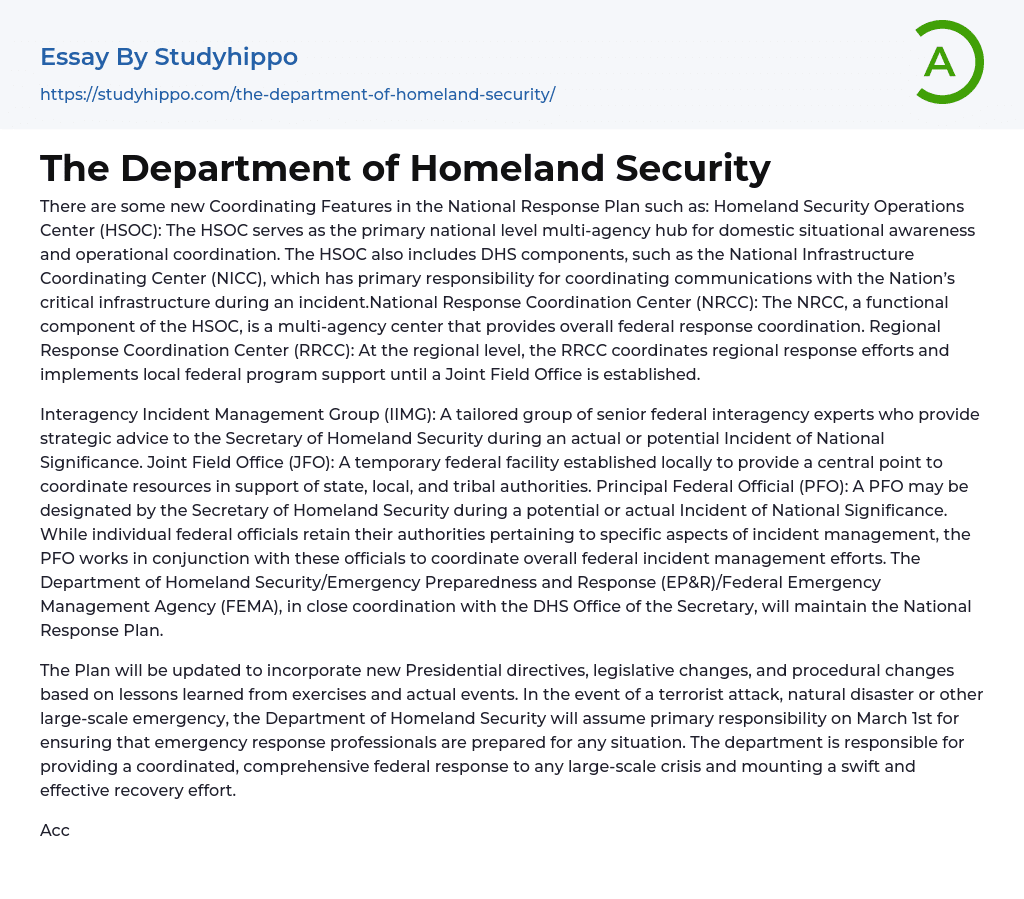The National Response Plan introduces several new Coordinating Features. One of them is the Homeland Security Operations Center (HSOC), which serves as the primary hub for domestic situational awareness and operational coordination at the national level. The HSOC also houses DHS components like the National Infrastructure Coordinating Center (NICC), responsible for coordinating communications with critical infrastructure during incidents.
Another feature is the National Response Coordination Center (NRCC), which operates as a multi-agency center overseeing federal response coordination and functions as a functional component of the HSOC.
At the regional level, there is the Regional Response Coordination Center (RRCC) that coordinates response efforts and provides support to local federal programs until a Joint Field Office is established.
The Interagency Incident Management Group (IIMG) consists of senior federal interagency experts who provide strategic advice to the Secretary of Homeland Security during actual or potentia
...l Incidents of National Significance.
Lastly, there is the Joint Field Office (JFO), which acts as a temporary federal facility established locally to centralize resource coordination in collaboration with state, local, and tribal authorities.
The Secretary of Homeland Security has the power to appoint a Principal Federal Official (PFO) in cases of potential or actual Incidents of National Significance. Although other federal officials have control over specific aspects of incident management, the PFO collaborates with these officials to coordinate overall federal incident management efforts. The Department of Homeland Security/Emergency Preparedness and Response (EP&R)/Federal Emergency Management Agency (FEMA), along with the DHS Office of the Secretary, will regularly update and maintain the National Response Plan. This plan will incorporate new Presidential directives, legislative changes, and procedural adjustments informed by insights gained from exercises and real-life incidents.
Starting from March 1st, th
Department of Homeland Security will have the primary responsibility of ensuring preparedness among emergency response professionals for large-scale emergencies such as terrorist attacks or natural disasters. Their main goal is to provide a well-coordinated and comprehensive federal response in these crises and assist in the recovery effort swiftly and effectively. As required by the Homeland Security Act of 2002, their mission is to prevent terrorist attacks, reduce vulnerability to terrorism, and minimize the impact of any terrorist attacks that may occur. Moreover, biohazards include agents or substances that pose a health risk to workers or the community, encompassing both infectious and noninfectious organisms.
Biohazards, which encompass infectious microorganisms, toxic biological substances, and biological allergens, can be utilized as weapons of mass destruction by terrorists. The anthrax virus serves as an example of a biohazard used to disseminate disease, death, fear, and panic among the public. Consequently, both the CDC (Center for Disease Control and Prevention) and the Department of Homeland Security have a shared interest in dealing with biohazards.
The CDC functions as one of the 13 major operating components under the Department of Health and Human Services (HHS). The HHS has the responsibility to ensure the health and safety of all Americans while providing essential human services, particularly for vulnerable populations. Since its establishment in 1946 with a primary focus on combatting malaria, the CDC has been at the forefront of efforts to prevent and control infectious diseases, chronic illnesses, injuries, workplace dangers, disabilities, and environmental health risks. Presently it is globally acknowledged for its proactive research initiatives and investigations aimed at addressing public health issues.
The CDC sets itself apart from other agencies by using research
and findings to improve everyday lives and tackle health emergencies. The agency establishes health impact goals to focus its efforts and track progress. Additionally, the CDC is tasked with combating biohazards like anthrax, plague, and tularemia that are utilized by terrorists. It is essential for them to be well-prepared in handling bioterrorism, chemical emergencies, radiation emergencies, mass casualties, natural disasters, severe weather events, and disease outbreaks.
- Pregnancy essays
- Death essays
- Asthma essays
- Chronic Pain essays
- Diabetes essays
- Infection essays
- Infertility essays
- Pain essays
- Sexually Transmitted Disease essays
- Cholesterol essays
- Epidemic essays
- Pathogen essays
- Symptom essays
- Water supply essays
- Myocardial Infarction essays
- Chronic essays
- Hypertension essays
- Black Death essays
- Breast Cancer essays
- Down Syndrome essays
- Apoptosis essays
- Tuskegee Syphilis Experiment essays
- Type 2 Diabetes essays
- Social Care essays
- Epidemiology essays
- Drug Addiction essays
- Hiv essays
- Hygiene essays
- Obesity essays
- Teenage Pregnancy essays
- Birth Control essays
- Eating Disorders essays
- Causes Of Obesity essays
- Children Obesity essays
- Internet Privacy essays
- Cyber Security essays
- Addiction essays
- Anatomy and Physiology essays
- Biodegradation essays
- Cancer essays
- Dental Care essays
- Disability essays
- Disease essays
- Disorders essays
- Health Care essays
- Infectious Disease essays
- Inquiry essays
- Intelligence Quotient essays
- Lung Cancer essays
- Medicine essays




